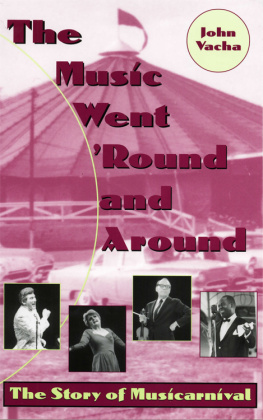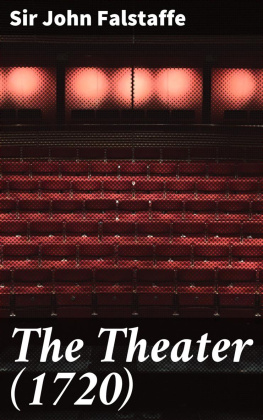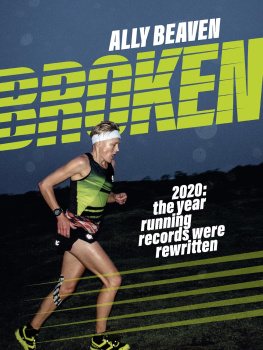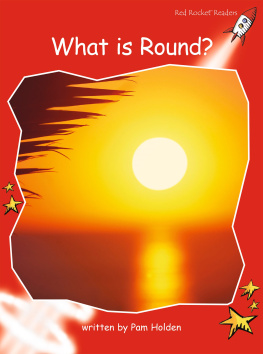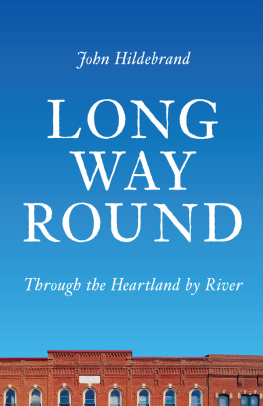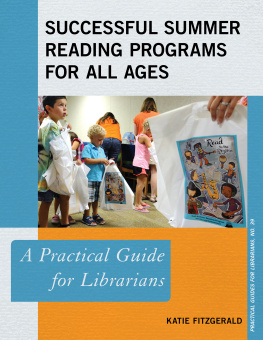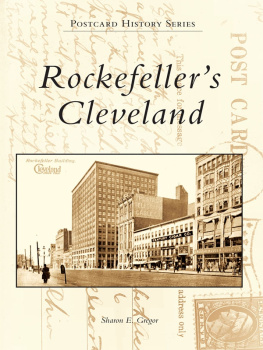
The
Music
Went
Round
and
Around
The
Music
Went
Round
and
Around
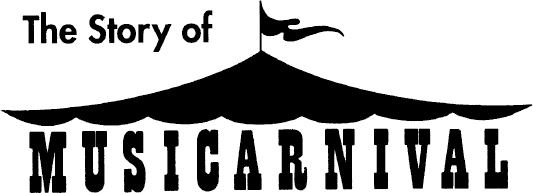
John Vacha
The Kent State University Press Kent and London
2004 by The Kent State University Press, Kent, Ohio 44242
ALL RIGHTS RESERVED
ISBN 0-87338-798-8
Library of Congress Catalog Card Number 2003028275
Manufactured in the United States of America
08 07 06 05 04 5 4 3 2 1
LIBRARY OF CONGRESS CATALOGING-IN-PUBLICATION DATA
Vacha, John.
The music went round and around : the story of Musicarnival / John Vacha.
p. cm.
Includes bibliographical references and index.
ISBN 0-87338-798-8 (pbk.: alk. paper)
1. Musicarnival (Warrensville Heights, Ohio)
2. Musical theaterOhioClevelandHistory.
I. Title.
ML1711.8.C57V3 2004
782.1'079'77131dc22
2003028275
British Library Cataloging-in-Publication data are available.
To the memory of
My Mother and Father:
Norma S. and Edward O. Vacha
Contents

Preface: Welcome to
Musicarnival!
Whenever I think of South Pacific, I visualize it in the round. The Rodgers and Hammerstein characters populate a circular, nearly bare stage, symbolic of the lonely island on which the action takes place. They are surrounded on all sides by an unbroken seathe faces of the audience. I first saw South Pacific, of course, at Musicarnival.
Along with an entire generation of Clevelanders, I saw quite a few classics of the American musical stage for the first time at Musicarnival. For those of us who missed the touring New York companies at the Hanna Theatre, John Prices tent theater in Warrensville Heights more often than not gave us our next chance to catch those shows in a professional production. It first opened its flaps in 1954, during the golden age of the American musical, and kept its pennant fluttering above the Queen of the Big Tops for the following twenty-two summers. In many respects, the history of Musicarnival, especially for the production years, is the history in microcosm of that original American art form.
Although theater is probably the most collaborative of art forms, any history of Musicarnival is to a large degree a biography of its founder and guiding genius, John L. Price Jr. The full list of his credits would include a great many of the significant theatrical enterprises of his era in Cleveland, but Musicarnival is the connective tissue that binds them all together. Fortunately he was also a saver, and the John L. Price Jr. Musicarnival Archives provide as rich a documentary record as left by any local theater.
In undertaking this history of Musicarnival, then, I am indebted first and foremost to John Price for donating his archives to the Cleveland Public Library. Next, Mrs. Evelyn Ward and the staff of that institutions literature department made those materials available in record time and were unfailingly accommodating and helpful to me in my research. Retired theater librarian Herbert Mansfield provided greatly appreciated guidance through the picture and slide collection. Several people helped fill in, elucidate, and complement the printed record by sharing their memories of Musicarnival through oral interviews, including those of John Price, William Boehm, Diana Price, Jock Price, Frank Baloga, and Keith Joseph. Quotations taken from these interviews may be recognized by verbs of attribution in the present tense. I am grateful moreover to Diana Price for reviewing the manuscript in the interest of accuracy. Final responsibility for accuracy of fact as well as opinion rests, as always, with the author.
Finally, I would like to thank the editors and staff of the Kent State University Press for their encouragement in inaugurating this series on individual Cleveland theaters as an extension of our general history, Showtime in Cleveland. Thanks also to my wife, Ruta, for continued patience and support, and to my niece, Audrey Dadzitis Hopkins, for putting me right with the computer age.
And now, settle back in your canvas deck chair as the house lights dim. If youre on the aisle, you may feel a sudden stir of warm summer air as a figure races past from the back of the house and bounds confidently up onto the white stage. A young man in a crew cut and red blazer peers out at that encircling sea of faces and addresses them in a ringing tenor: Good evening, neighbors, and welcome to Musicarnival!
During the spring of 1954 a young Navy veteran suddenly began hanging around the racetrack. His mother, Emma Price, and his wife, Connie, were not overly concerned; they knew that Johnny Price wasnt smitten by the ponies. Both had had their flings with the stage, and they knew that John was simply incurably stagestruck. Where railbirds watched thoroughbreds rounding the final turn into the homestretch, Price envisioned chorus girls breaking into their routines just beyond the oval rail.
What Price had in mind for the northwestern corner of the Thistledown grounds near the intersection of Warrensville Center and Emery Roads was a new and unique summer theater. Inspired by a recent trend on the East Coast, he planned to produce musical shows under a huge, circuslike tent. The big-top imagery would inspire, or more accurately necessitate, the adoption of another contemporary theatrical trend. In the tradition of Ringling Brothers and other circus impresarios, Price would be staging his shows on a circular platform right in the middle of his audiencein the round.
Summer theaters in themselves were nothing new in the Cleveland theatrical tradition. Nearly a century earlier, Clevelanders had begun patronizing Haltnorths Gardens on Kinsman Road. At first this was a simple German beer garden, viewed suspiciously by the earlier settlers with their New England Congregational origins. The Cleveland Leader in 1863 labeled it the citys greatest nuisance, a gathering place for pickpockets, prostitutes, and shoulder hitters (whatever that wasperhaps nineteenth-century slang for purse snatchers). By 1872, after its relocation at Willson (East 55th) and Woodland Avenue, Haltnorths had become a widely popular gathering place with spacious grounds laid out around a picturesque pond. One of its chief attractions was a theater that featured concerts and operettas by the Holman Opera Company, among others. All the popular Gilbert and Sullivan shows, from H.M.S. Pinafore to Patience, could be seen there in the 1880s and 1890s.
There was even a summer tent theater in the citys past. The Cleveland Pavilion Theater flourished in the 1880s between Wood (East 4th) and Bond (East 6th) Streets, probably in the old Lake View Park, descending from the bluffs to the railroad tracks along Lake Erie. It could accommodate up to two thousand spectators under canvas to view musical productions such as The Chimes of Normandy.
With the turn of the century, summer theatrics shifted to the Euclid Avenue Garden Theater, which opened in 1904 at Euclid Avenue and Kennard (East 40th) Street. Unlike Haltnorths, these gardens were described by a patron, Edith Moriarty, as a temperance theater. Moriarty recalled, Green grass and trees, tables, umbrellas and chairs, invited the audience, particularly the young girls on Saturday afternoons, spending their allowances on the matinee, with sodas and root beer between the acts. There was a stuccoed pavilion of Spanish Moorish design set two hundred feet back from the street, open to the air on three sides, and facing the stage on the fourth. Typical of the musical fare was Gilbert and Sullivans

